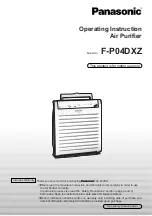
18
MAINTENANCE INSTRUCTIONS
ENGLISH
Belt Tension Testing Procedure
Belt tension checker
Measure the belt deflection force
NOTE
Tension new drives at the maximum deflection force recommended. Check the tension at
least two times during the first day’s operation as there normally will be a rapid decrease in
belt tension until belts have run in. Check the tension periodically after the first day’s
operation and keep tension at which the belts will not slip under the peak load conditions.
Shafts must be adequate for the tensions required.
Small
“0”
Ring
Force Scale
Span Scale
Large
“0”
Ring
Deflection =
Belt Span
Belt Span
64
Belt Tension Testing Procedure instruction
To determine the lbs. force required to tension a drive, you simply do the following:
1. Measure the Belt span as shown.
2. Divide belt span by 64 to get belt deflection needed to check tension.
3. Set large “0” ring on span scale at required belt deflection. This scale is in 1/16” increments.
4. Set small “0” ring at zero on the “Force Scale”(plunger).
5. Place the larger end of the tension checker squarely on one belt at the center of the belt span.
Apply force on the plunger until the bottom of the large “0” ring is even with the top of the
next belt or with the bottom of a straight edge laid across the sheaves.
6. Read the force scale under the small “0” ring to determine force required to give the needed
deflection.
7. Compare the force scale reading with the correct value for the belt style and cross section
used, as given in table on next page. The force should be between the minimum and
maximum values shown.
8. If there is too little deflection force, the belts should be tightened. If there is too much
deflection force, the belts should be loosened.
Summary of Contents for AK-C3608H00
Page 38: ...ENGLISH 38 ...
















































